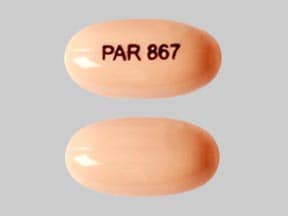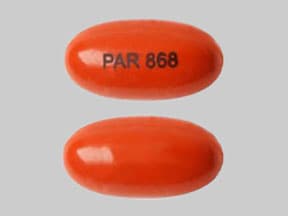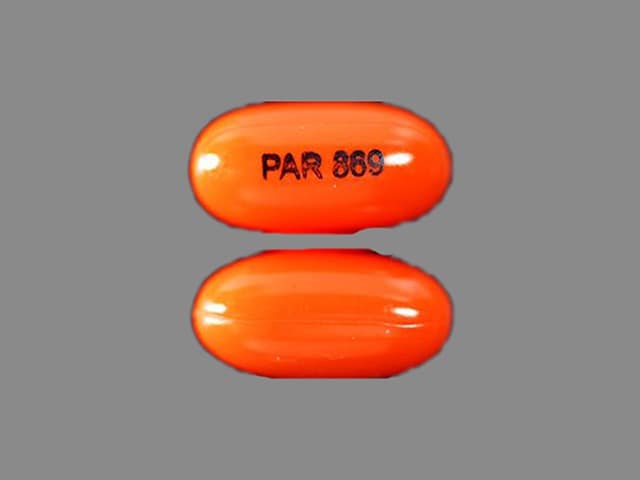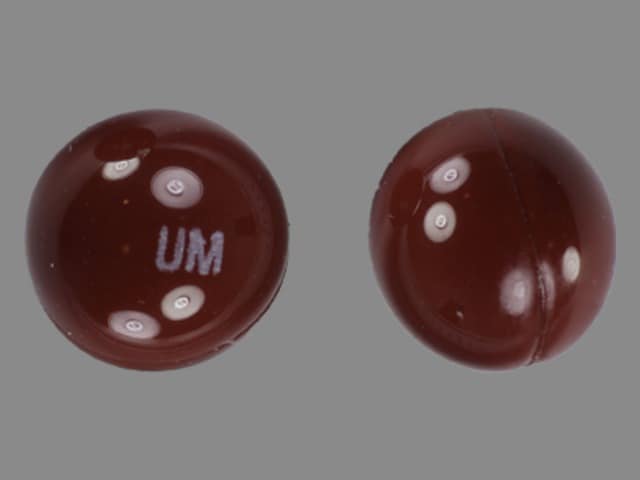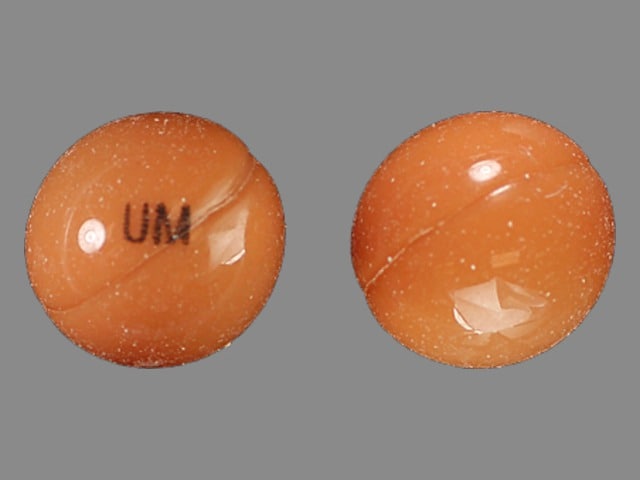Dosage Forms
Excipient information presented when available (limited, particularly for generics); consult specific product labeling. [DSC] = Discontinued product
Capsule, Oral:
Marinol: 2.5 mg [DSC], 5 mg [DSC], 10 mg [DSC] [contains sesame oil]
Generic: 2.5 mg, 5 mg, 10 mg
Solution, Oral:
Syndros: 5 mg/mL (30 mL) [contains alcohol, usp, methylparaben, polyethylene glycol, propylene glycol, propylparaben]
Pharmacology
Mechanism of Action
Dronabinol (synthetic delta-9-tetrahydrocannabinol [delta-9-THC]), an active cannabinoid and natural occurring component of Cannabis sativa L. (marijuana), activates cannabinoid receptors CB1 and CB2. Activation of the CB1 receptor produces marijuana-like effects on psyche and circulation, whereas activation of the CB2 receptor does not. Dronabinol has approximately equal affinity for the CB1 and CB2 receptors; however, efficacy is less at CB2 receptors. Activation of the cannabinoid system with dronabinol causes psychological effects that can be divided into 4 groups: affective (euphoria and easy laughter); sensory (increased perception of external stimuli and of the person's own body); somatic (feeling of the body floating or sinking in the bed); and cognitive (distortion of time perception, memory lapses, difficulty in concentration). Most effects (eg, analgesia, appetite enhancement, muscle relaxation, hormonal actions) are mediated by central cannabinoid receptors (CB1), their distribution reflecting many of the medicinal benefits and adverse effects (Grotenhermen 2003).
Pharmacokinetics/Pharmacodynamics
Absorption
Oral: 90% to 95%; 10% to 20% of dose reaches systemic circulation
Distribution
Vd: ~10 L/kg; dronabinol is highly lipophilic
Metabolism
Extensive first-pass hepatic primarily via microsomal hydroxylation to metabolites, some of which are active; 11-hydroxy-delta-9-tetrahydrocannabinol (11-OH-THC) is the major active metabolite
Excretion
Feces (50%, <5% as unchanged drug); urine (10% to 15%)
Onset of Action
~0.5 to 1 hour; Peak effect: 2 to 4 hours
Time to Peak
Serum: 0.5 to 4 hours
Duration of Action
4 to 6 hours (psychoactive effects); ≥24 hours (appetite stimulation)
Half-Life Elimination
Biphasic: Alpha: 4 to 5 hours; Terminal: 25 to 36 hours
Protein Binding
~97%
Use: Labeled Indications
Anorexia in patients with AIDS: Treatment of anorexia associated with weight loss in patients with AIDS.
Chemotherapy-induced nausea and vomiting: Treatment of nausea and vomiting associated with cancer chemotherapy in patients who have failed to respond adequately to conventional antiemetic treatments.
Use: Off Label
Obstructive sleep apnea, moderate to severec
Initial data from a blinded parallel group, placebo-controlled, randomized phase 2 trial suggests dronabinol may have therapeutic potential in the management of moderate to severe obstructive sleep apnea. Additional controlled trials are needed to further define the role of dronabinol in this condition.
Contraindications
Hypersensitivity to dronabinol, sesame oil (capsules), alcohol (oral solution) or any component of the formulation; receiving, or have recently received, disulfiram- or metronidazole-containing products within 14 days (oral solution).
Dosage and Administration
Dosing: Adult
Note: Use caution when increasing the dose of dronabinol because of the increased frequency of dose-related adverse reactions at higher dosages.
Anorexia in patients with AIDS: Oral:
Capsules: Initial: 2.5 mg twice daily (1 hour before lunch and dinner); for patients unable to tolerate this dosage, may reduce to 2.5 mg once daily (1 hour before dinner or at bedtime to reduce the risk of CNS symptoms). May increase dose gradually based on response and tolerability (maximum: 20 mg per day [in divided doses]).
Oral solution: Initial: 2.1 mg twice daily (1 hour before lunch and dinner); although most patients respond to this dose, if further therapeutic effect is desired and if tolerated, may gradually increase to 2.1 mg 1 hour before lunch and 4.2 mg 1 hour before dinner, and then (if needed) to 4.2 mg twice daily (1 hour before lunch and dinner). Maximum: 16.8 mg per day [in 2 divided doses]. In patients unable to tolerate 2.1 mg twice daily, consider 2.1 mg once daily (1 hour before dinner or at bedtime) to reduce the risk of CNS effects.
Chemotherapy-induced nausea and vomiting (manufacturer's labeling): Oral:
Capsules: 5 mg/m2 administered 1 to 3 hours before chemotherapy, then give 5 mg/m2/dose every 2 to 4 hours after chemotherapy for a total of 4 to 6 doses/day; increase dose in increments of 2.5 mg/m2 based on response and tolerability (maximum: 15 mg/m2/dose). Monitor for adverse reactions; consider reducing dose to 2.5 mg once daily 1 to 3 hours prior to chemotherapy to reduce the risk of CNS adverse reactions.
Oral solution: Initial: 4.2 mg/m2 (rounded to the nearest 0.1 mg increment [or to the nearest 0.1 mL measurable increment on the calibrated oral dosing syringe]) 1 to 3 hours prior to chemotherapy and then every 2 to 4 hours after chemotherapy for a total of 4 to 6 doses/day. Titrate dose in 2.1 mg/m2 increments (during a cycle or in subsequent cycles) to clinical response. Maximum: 12.6 mg/m2/dose and 4 to 6 doses/day. In patients unable to tolerate 4.2 mg/m2, consider 2.1 mg/m2 once daily 1 to 3 hours prior to chemotherapy to reduce the risk of CNS effects.
Chemotherapy-induced nausea and vomiting, refractory (off-label dosing): Oral: Capsules: 2.5 to 10 mg 3 or 4 times daily (Lohr 2008)
Obstructive sleep apnea, moderate to severe (off-label use): Oral: 2.5 mg or 10 mg 1 hour before bedtime. An initial dose escalation is required for the 10 mg dose: Initiate at 2.5 mg 1 hour before bedtime for 7 days, followed by 5 mg 1 hour before bedtime for 7 days, and then 10 mg 1 hour before bedtime (Carley 2018).
Dosing: Geriatric
Capsules:
Anorexia in patients with AIDS: Initial: Consider 2.5 mg once daily (1 hour before dinner or at bedtime) to reduce the risk of CNS symptoms.
Chemotherapy-induced nausea and vomiting: Initial: Consider 2.5 mg/m2 once daily 1 to 3 hours prior to chemotherapy to reduce the risk of CNS symptoms.
Oral solution:
Anorexia in patients with AIDS: Initial: Consider 2.1 mg once daily (1 hour before dinner or at bedtime) to reduce the risk of CNS effects.
Chemotherapy-induced nausea and vomiting: Initial: Consider 2.1 mg/m2 once daily 1 to 3 hours prior to chemotherapy to reduce the risk of CNS effects.
Dosing: Pediatric
Note: Use caution when increasing the dose of dronabinol because of the increased frequency of dose-related adverse reactions at higher dosages. Dronabinol is available in capsules and an oral solution; they are not bioequivalent and should not be used interchangeably; dosing is different for the same indication due to bioavailability differences.
Chemotherapy-induced nausea and vomiting, refractory: Note: Initiate with the lowest recommended dose and titrate to response; based on initial results, the dose may be escalated during a chemotherapy cycle or with subsequent cycles. Children and Adolescents: Oral: Capsules: 5 mg/m2 administered 1 to 3 hours before chemotherapy, then give 5 mg/m2/dose every 2 to 4 hours after chemotherapy for a total of 4 to 6 doses/day; increase doses in increments of 2.5 mg/m2 based on response and tolerability; maximum dose: 15 mg/m2/dose. In adults, usual fixed doses of 2.5 to 10 mg 3 or 4 times daily are used (Lohr 2008). Although FDA approved in pediatric patients, available data is limited and dosing extrapolated from experience in adult patients (minimum reported age in pediatric patient: 9 years [Tramèr 2001]); some experts suggest avoiding use in children <6 years, and using with caution in patients 6 to 12 years (Orkin 2009)
Dosing adjustment for toxicity: The presented dosing adjustments are based on experience in adult patients; specific recommendations for pediatric patients are limited.
Adult:
Appetite stimulation in AIDS patients: CNS adverse reactions: Reduce dose if needed. Note: Administering the dose later in the day may reduce the frequency of CNS adverse effects.
Dizziness, somnolence, confusion, or euphoria: Adverse effects typically resolve within 1 to 3 days and usually do not require dose reduction
Severe or persistent CNS adverse effects: Reduce dose to 2.1 mg (solution) or 2.5 mg (capsule) once daily 1 hour before dinner or in the evening at bedtime
In patients unable to tolerate 2.1 mg twice daily (solution), consider 2.1 mg once daily (1 hour before dinner or at bedtime) to reduce the risk of CNS effects
Chemotherapy-induced nausea and vomiting: CNS adverse reactions: Consider decreasing the adult dose to 2.1 mg (solution) or 2.5 mg (capsule) once daily 1 to 3 hours prior to chemotherapy to reduce the risk of CNS adverse reactions
Dosing: Adjustment for Toxicity
Anorexia in patients with AIDS:
CNS adverse reactions: Reduce dose if needed. Note: Administering the dose later in the day may reduce the frequency of CNS adverse effects.
Dizziness, somnolence, confusion, or euphoria: Adverse effects typically resolve within 1 to 3 days and usually do not require dose reduction.
Severe or persistent CNS adverse effects: Reduce dose to 2.1 mg once daily 1 hour before dinner or in the evening at bedtime.
In patients unable to tolerate 2.1 mg twice daily, consider 2.1 mg once daily (1 hour before dinner or at bedtime) to reduce the risk of CNS effects.
Chemotherapy-induced nausea and vomiting:
CNS adverse reactions: Consider decreasing the dose to 2.1 mg once daily 1 to 3 hours prior to chemotherapy to reduce the risk of CNS adverse reactions.
Administration
Capsules:
Anorexia in patients with AIDS: Administer twice-daily doses 1 hour before lunch and dinner; administer single doses 1 hour before dinner or at bedtime.
Chemotherapy-induced nausea and vomiting: Administer the first dose on an empty stomach at least 30 minutes before eating; subsequent doses may be administered without regard to meals, although once titrated, the timing of administration in relation to meals should be kept consistent for each chemotherapy cycle.
Oral solution: Always use the provided calibrated oral dosing syringe when administering to ensure dose is measured and administered accurately. If the prescribed dose is >5 mg, the total dose will need to be divided and drawn up in 2 or more portions using the oral syringe. Administer orally directly from oral dosing syringe; immediately follow with a full glass of water (180 to 240 mL). May also be administered through silicone-based enteral feeding tubes that are size ≥14 French (eg, nasogastric [NG], gastrostomy tube [G-tube], percutaneous endoscopic gastrostomy tube [PEG-tube], and gastro-jejunostomy tube [GJ-tube]); do not use polyurethane tubing; after administration, flush feeding tube with 30 mL of water using a catheter-tip syringe.
Anorexia in patients with AIDS: Administer 1 hour before lunch and 1 hour before dinner initially; if persistent or severe CNS adverse effects occur, administering later in the day (1 hour before dinner and at bedtime) may reduce the frequency of CNS adverse effects.
Chemotherapy-induced nausea and vomiting: The first dose should be administered on an empty stomach at least 30 minutes prior to eating; subsequent doses within a chemotherapy cycle may be administered without regard to meals. Once a dose has been titrated, the timing of doses with regard to food in subsequent cycles should maintain consistency with prior cycles.
Dietary Considerations
Capsules contain sesame oil.
Storage
Capsule: Store in a cool environment between 8°C and 15°C (46°F and 59°F) or refrigerated; protect from freezing. Capsules should be stored in a well-closed container.
Oral solution: Store in a refrigerator between 2°C and 8°C (36°F and 46°F); excursions permitted up to 25°C (77°F). The opened bottle may be stored at 25°C (77°F). Discard unused portion 42 days after first opening. Keep in original carton (keep calibrated dosing syringe in original carton, too).
Dronabinol Images
Drug Interactions
Alcohol (Ethyl): Dronabinol may enhance the CNS depressant effect of Alcohol (Ethyl). Monitor therapy
Amphotericin B: Dronabinol may increase the serum concentration of Amphotericin B. Specifically, dronabinol may displace amphotericin B from its protein-binding sites, leading to an increased concentration of active, unbound drug. Monitor therapy
Anticholinergic Agents: May enhance the tachycardic effect of Cannabinoid-Containing Products. Monitor therapy
CNS Depressants: Dronabinol may enhance the CNS depressant effect of CNS Depressants. Monitor therapy
Cocaine (Topical): May enhance the tachycardic effect of Cannabinoid-Containing Products. Monitor therapy
CycloSPORINE (Systemic): Dronabinol may increase the serum concentration of CycloSPORINE (Systemic). Specifically, dronabinol may displace cyclosporine from its protein-binding sites, leading to an increased concentration of active, unbound drug. Monitor therapy
CYP2C9 Inhibitors (Moderate): May increase the serum concentration of Dronabinol. Monitor therapy
CYP3A4 Inducers (Strong): May decrease the serum concentration of Dronabinol. Monitor therapy
CYP3A4 Inhibitors (Moderate): May increase the serum concentration of Dronabinol. Monitor therapy
CYP3A4 Inhibitors (Strong): May increase the serum concentration of Dronabinol. Monitor therapy
Disulfiram: May enhance the adverse/toxic effect of Dronabinol. Specifically, disulfiram may produce severe intolerance to the alcohol contained in the dronabinol oral solution. Consider therapy modification
MetroNIDAZOLE (Systemic): May enhance the adverse/toxic effect of Dronabinol. Specifically, metronidazole may produce severe intolerance to the alcohol contained in the dronabinol oral solution. Consider therapy modification
Ritonavir: May increase the serum concentration of Dronabinol. Monitor therapy
Sympathomimetics: Cannabinoid-Containing Products may enhance the tachycardic effect of Sympathomimetics. Monitor therapy
Warfarin: Dronabinol may increase the serum concentration of Warfarin. Specifically, dronabinol may displace warfarin from its protein-binding sites, leading to an increased concentration of active, unbound drug. Monitor therapy
Adverse Reactions
Frequency not always defined.
>10%: Central nervous system: Euphoria (antiemetic: 24%; appetite stimulant: 8%)
1% to 10%:
Cardiovascular: Facial flushing (>1%), palpitations (>1%), tachycardia (>1%), vasodilation (>1%), flushing (≤1%), hypotension (≤1%)
Central nervous system: Abnormality in thinking (3% to 10%), dizziness (3% to 10%), drowsiness (3% to 10%), paranoia (3% to 10%), amnesia (>1%), anxiety (>1%), ataxia (>1%), confusion (>1%), depersonalization (>1%), hallucination (>1%), nervousness (>1%), chills (≤1%), depression (≤1%), headache (≤1%), malaise (≤1%), nightmares (≤1%), speech disturbance (≤1%)
Dermatologic: Diaphoresis (≤1%)
Gastrointestinal: Abdominal pain (3% to 10%), nausea (3% to 10%), vomiting (3% to 10%), anorexia (≤1%), diarrhea (≤1%), fecal incontinence (≤1%)
Hepatic: Increased liver enzymes (≤1%)
Neuromuscular & skeletal: Weakness (>1%), myalgia (≤1%)
Ophthalmic: Conjunctival injection (≤1%), conjunctivitis (≤1%), visual disturbance (≤1%)
Otic: Tinnitus (≤1%)
Respiratory: Cough (≤1%), rhinitis (≤1%), sinusitis (≤1%)
<1%, postmarketing, and/or case reports: Burning sensation of skin, delirium, disorientation, exacerbation of depression, falling, fatigue, insomnia, loss of consciousness, mental status changes (exacerbation of mania or schizophrenia), movement disorder, oral lesion, panic attack, pharyngeal edema, seizure, skin rash, swelling of lips, syncope, urticaria, visual disturbance
Warnings/Precautions
Concerns related to adverse effects:
- Cardiovascular effects: May cause occasional hypotension, possible hypertension, syncope, or tachycardia; patients with cardiac disorders may be at higher risk for hemodynamic instability. Monitor for changes in heart rate, blood pressure, and for signs/symptoms of syncope after initiating treatment and with dosage increases. Avoid concomitant use with other medications associated with similar cardiovascular adverse effects.
- CNS adverse effects: Monitor for CNS adverse effects; may require dosage modification. Dronabinol has been reported to exacerbate depression, mania, or schizophrenia; screen patients for history of these conditions prior to treatment initiation. Significant CNS symptoms were associated with doses of 0.4 mg/kg in antiemetic studies. Avoid use in patients with a psychiatric history; if use cannot be avoided, monitor for new or worsening psychiatric symptoms. Avoid concomitant use with other medications associated with similar psychiatric adverse effects. May cause cognitive impairment, altered mental state, or CNS depression, which may impair physical or mental abilities; patients must be cautioned about performing tasks that require mental alertness (eg, operating machinery, driving). Elderly and pediatric patients may be more sensitive to neurologic and psychiatric effects of dronabinol. May require dose reduction or discontinuation.
- GI effects: New or worsening paradoxical nausea, vomiting, and/or abdominal pain may occur with synthetic cannabinoids; may be severe. Symptoms are similar to cannabinoid hyperemesis syndrome, which is a cyclical syndrome with the same symptoms occurring with long-term use of cannabinoid products. Monitor patients for specific related symptoms; development of worsening nausea, vomiting or abdominal pain may require dose reduction or discontinuation.
- Hypersensitivity: Hypersensitivity reactions, including disseminated rash, hives, lip swelling, oral lesions, skin burning, flushing, and throat tightness, have been reported.
- Seizures: Dronabinol has been associated with seizures and seizure-like activity. Assess potential risks versus benefits in patient with a history of seizure disorder, those receiving anti-epileptic medications, or with other factors that may lower the seizure threshold. Monitor patients with a history of seizure disorder for worsened control. Discontinue dronabinol immediately in patients who develop seizures.
Disease-related concerns:
- Substance abuse: Patients with a history of substance abuse (including marijuana or alcohol abuse) or dependence may be likely to also abuse dronabinol. Assess risk for abuse or misuse prior to treatment and monitor patients with a history of substance abuse throughout treatment. Tolerance, psychological, and physical dependence may occur with prolonged use. EEG changes consistent with withdrawal have been reported upon abrupt dechallenge of dronabinol. Sleep disturbances have been observed for several weeks after discontinuing treatment with high dronabinol doses.
Concurrent drug therapy issues:
- Disulfiram reaction: Dronabinol oral solution contains dehydrated alcohol, which may cause a disulfiram-like reaction (abdominal cramps, nausea, vomiting, headache, and flushing) in patients receiving disulfiram or other medications associated with this reaction (eg, metronidazole). Medications containing disulfiram or metronidazole should be discontinued at least 14 days prior to initiation of dronabinol oral solution and do not administer until 7 days following completion of dronabinol oral solution.
- Drug-drug interactions: Potentially significant interactions may exist, requiring dose or frequency adjustment, additional monitoring, and/or selection of alternative therapy. Consult drug interactions database for more detailed information.
Special populations:
- CYP2C9 polymorphism: Clearance may be reduced and systemic effects increased in patients with CYP2C9 genetic polymorphism. Monitor for increased adverse effects in patients known to carry genetic variants associated with diminished CYP2C9 function.
- Elderly: Because elderly patients may be more sensitive to the neurological, psychoactive, and postural hypotensive effects of dronabinol, use with caution. Consider reduced initial doses. Elderly patients with dementia are already at increased risk for falls and fall risk may be exacerbated with dronabinol; monitor closely.
- Pediatric patients: Safety and efficacy of dronabinol oral solution have not been established in pediatric patients. Dronabinol oral solution contains dehydrated alcohol and propylene glycol, which should be avoided in preterm neonates and in the immediate postnatal period due to possible toxicities associated with propylene glycol. Pediatric patients may be more sensitive to CNS adverse effects.
Other warnings/precautions:
- Propylene glycol: Some dosage forms may contain propylene glycol; large amounts are potentially toxic and have been associated hyperosmolality, lactic acidosis, seizures, and respiratory depression; use caution (AAP 1997; Zar 2007). See manufacturer's labeling.
- Withdrawal: May cause withdrawal symptoms upon abrupt discontinuation.
Monitoring Parameters
Monitor heart rate and blood pressure. Monitor for CNS adverse effects, seizures (including worsened seizure control), new or worsening psychiatric symptoms, development of worsening nausea, vomiting or abdominal pain, and substance abuse behavioral profile.
Pregnancy
Pregnancy Considerations
Although information related to the use of synthetic cannabinoids during pregnancy is limited, cannabinoids cross the placenta. Maternal use may increase the risk of adverse fetal/neonatal outcomes including growth restriction, low birth weight, preterm birth, and stillbirth. Some dosage forms also contain a significant amount of alcohol.
Patient Education
What is this drug used for?
- It is used to help you eat more.
- It is used to treat upset stomach and throwing up.
Frequently reported side effects of this drug
- Euphoria
Other side effects of this drug: Talk with your doctor right away if you have any of these signs of:
- Confusion
- Difficulty focusing
- Severe dizziness
- Passing out
- Severe headache
- Behavioral changes
- Mood changes
- Sensing things that seem real but are not
- Fast heartbeat
- Change in balance
- Mouth sores
- Burning
- Flushing
- Severe fatigue
- Abdominal pain
- Trouble with memory
- Seizures
- Vision changes
- Nausea
- Vomiting
- Signs of a significant reaction like wheezing; chest tightness; fever; itching; bad cough; blue skin color; seizures; or swelling of face, lips, tongue, or throat.
Note: This is not a comprehensive list of all side effects. Talk to your doctor if you have questions.
Consumer Information Use and Disclaimer: This information should not be used to decide whether or not to take this medicine or any other medicine. Only the healthcare provider has the knowledge and training to decide which medicines are right for a specific patient. This information does not endorse any medicine as safe, effective, or approved for treating any patient or health condition. This is only a brief summary of general information about this medicine. It does NOT include all information about the possible uses, directions, warnings, precautions, interactions, adverse effects, or risks that may apply to this medicine. This information is not specific medical advice and does not replace information you receive from the healthcare provider. You must talk with the healthcare provider for complete information about the risks and benefits of using this medicine.
